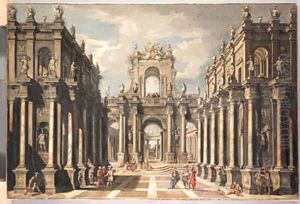Francesco Galli, Il Bibiena Paintings
Francesco Galli, better known as Il Bibiena, was an Italian architect, painter, and designer, most renowned for his work in the Baroque style. Born in 1659 in Bologna, Italy, into the Galli da Bibiena family, he was part of a dynasty of artists, architects, and stage designers that left a significant mark on European art, particularly in the realm of theatre design and architecture during the late 17th and early 18th centuries. Francesco was the son of Giovanni Maria Galli, and it was under his father's guidance that he first trained, setting the foundation for his illustrious career.
Francesco's work was characterized by the dramatic intensity and complexity of Baroque architecture and scenography. He excelled in creating intricate stage designs that utilized the innovative technique of angled perspective to enhance the depth and illusion of space, a method that became a hallmark of the Bibiena family's style. This technique was not only revolutionary in the context of theatrical design but also influenced architectural drawings and projects.
In 1686, Francesco's talents led him to the court of Parma, where he served the Farnese family. His reputation for creating magnificent and elaborate stage settings grew, and he was soon in demand across the courts of Europe, including those of Vienna, Munich, and Berlin. Among his notable works were the designs for the opera house in Parma and the wedding festivities of the Elector Palatine in Düsseldorf. His ability to blend architectural elements with theatrical illusion earned him widespread acclaim.
Francesco Galli Bibiena's legacy extends beyond his immediate creations. He was a mentor to his children, several of whom followed in his footsteps to become prominent artists in their own right. His influence can be seen in the continued prominence of the Bibiena family across Europe as designers and architects throughout the 18th century. Francesco died in 1739, but his innovative designs and contributions to Baroque art and architecture continued to inspire generations of artists and architects long after his death.
